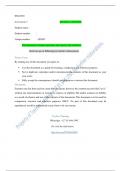ENG1503
Assessment 1 Due Date: 13/03/2024
Student name :
Student number :
Unique number : 285853
This document contains questions and step by step solutions.
Hook me up on WhatsApp for further elaborations.
Terms of use:
By making use of this document you agree to:
Use this document as a guide for learning, comparison and reference purpose,
Not to duplicate, reproduce and/or misrepresent the contents of this document as your
own work,
Fully accept the consequences should you plagiarise or misuse this document.
Disclaimer:
Extreme care has been used to create this document, however the contents are provided “as is”
without any representations or warranties, express or implied. The author assumes no liability
as a result of reliance and use of the contents of this document. This document is to be used for
comparison, research and reference purposes ONLY. No part of this document may be
reproduced, resold or transmitted in any form or by any means.
TeeVee Tutoring
WhatsApp: +27 81 844 1995
Or click the link below:
http://wa.me/27818441995
, 1.1.
In the workplace, bullying may occur due to power imbalances and competitive
environments. Firstly, hierarchical structures in companies can foster an environment
where those in positions of authority may abuse their power over subordinates, leading to
bullying behaviour.
For example, a manager constantly belittling and criticizing their junior employees could
contribute to a hostile work environment.
Secondly, in competitive industries, employees may feel pressure to outperform their
colleagues, leading to behaviours such as sabotage or spreading rumours to undermine
others. For instance, an employee intentionally withholding important information from a
co-worker to make them look incompetent could be a form of workplace bullying.
1.2.
Firstly, bullying involves the abuse of coercive power and can manifest as aggressive
behaviour causing harm or discomfort to another person. For instance, a supervisor
constantly berating a subordinate in front of their colleagues.





